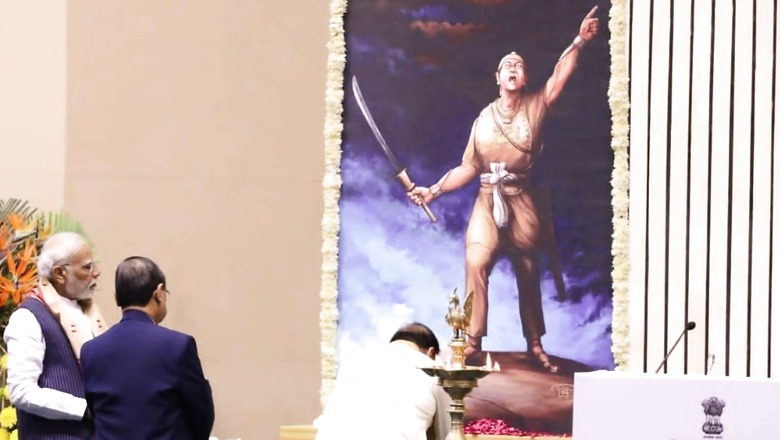
views
As hundreds of banana leaves with leftovers of lunch on them floated downstream past the Mughal war boats on the mighty, expansive Brahmaputra, their commander told his troops to relax. The Ahom army have just finished their meal and must be resting, they inferred.
Little did they realise that it was Lachit Borphukhan’s art of military illusion at play. The Ahom commander had made his men send those plantain leaves floating to lull his enemy into complacency and inaction. The stage was set for the warrior legend’s decisive assault.
Ahom troops swooped down in a land-and-river amphibious attack with the traditional one-edged Heng Dang swords, bows and arrows, javelins, guns, match-locks, and cannons.
The Mughal army was decimated on the shimmering waters of Burha Luit, or the old river, in one of the finest battles this civilisation has won to protect its people and culture from invaders.
When home minister Amit Shah recently said that but for Lachit, the map of India would have been different, he was not overstating. The Battle of Saraighat, and thereafter sub-battles like the Itakhuli Ronn, halted the march of Aurangzeb’s much-feared Mughal forces. If Lachit’s army had not routed them, most parts of Northeast India would have been Islamised and ended up in Pakistan during Partition.
Lachit Borphukan was as historically pivotal in the east as Shivaji Maharaj was in the west. Ahoms were as robust a bulwark against invasions and as stubbornly brave and resistant in their terrain as were the Marathas in theirs. Mughals could get a tiny, temporary foothold in Assam for just about eight years before Lachit’s army massacred them.
And still, why is the story of Lachit Borphukan and other great Ahoms not part of our school syllabus?
Why has this piece of precious history remained outside of mainstream academics without even being peer-reviewed for decades?
Why did Congress’s stalwart Ahom CMs like Hiteshwar Saikia and Tarun Gogoi do nothing to tell the story of Saraighat? (During Vajpayee’s government, after the Kargil war, the medal for the best cadet in the Nation Defence Academy was named after Lachit).
It is because this tale of greatest valour does not fit into the narrative of the Left-Islamist cabals that have dominated Indian academia and much of history-writing. The subplots of the tale are even more problematic for these vested interests.
So why is the Battle of Saraighat so relevant today and why does it make anti-India forces so uncomfortable?
First, it stands as the icon of this civilisation’s battle against invaders. It is the glowing instance of victory against demographic and cultural takeover. The war is poignantly most relevant today in the land where it happened.
Illegal migration from Bangladesh has skewed Assam’s demographics beyond recognition. From 24.68% in 1951, Muslim population had gone up to 34.22% in 2011. Soon, it could be pushing 40%. Along with demographics, the Assamese language and culture are at grave peril.
Second, Lachit’s inclusive leadership made Assam’s indigenous Muslims and tribals fight for their ancestral land and culture. His navy chief who fought against the Mughals was Ismail Siddique, also known as Bagh Hazarika. Islamisation in the Northeast happened through Sufi saints, not through Mughals and invaders. Which is why Muslims are strongly attached to the culture of the land. Artistes like Adil Hussain, for instance, celebrate the Bihu festival as ardently as Hindus.
Borphukan’s army also had a strategic collaboration with the tribal Koch kingdom of Kamrup. Koch troops were, in fact, the first line of defence against the Mughals.
Third, the Hindu overtones of that patriotic episode and the BJP subsequently embracing it make those who built their careers on minoritism very nervous. Some historians have tried to argue that Lachit Borphukan was not a Hindu at all because his clan, the Tai Ahoms, followed the indigenous Tai belief. That is a conveniently cherrypicked half-truth.
While the Tai Ahom community came from Hunan province in south China in the distant past, it settled in Assam and became Vaishnavite Hindus. It was an important part of the Shankar Deva movement in the 15th-16th century. Till date, all Ahoms celebrate the first day of Rongali Bihu as Goru Bihu. They bathe and clean a cow, give her special food, and worship her. The Siva dols, Vishnu dols, and Devi dols (dol is a temple) in Assam’s Sivasagar were built by Ahom kings and queens.
So, the attempt to de-Hinduise Ahoms and Lachit Borphukan can only be part of a sinister, Hinduphobic agenda.
And fourth, Lachit’s memory invokes the kind of uncompromising nationalism that India needs today. According to a popular story in Assam on the Battle of Saraighat, Lachit had given his uncle the task of building a dyke in a day to thwart the Mughals. On inspection, he found his uncle resting and chit-chatting with the labourers, the work remaining unfinished. He beheaded his uncle on the spot, saying: “My uncle is not greater than my desh or nation.”
In resurgent India, Lachit Borphukan is a name that every child must know. The spirit of Saraighat — the patriotic and cultural pride, military excellence with guerrilla and other tactics, and the ruthlessness of vanquishing the enemy — should be a guiding lighthouse for modern India.
Abhijit Majumder is a senior journalist. Views expressed are personal.
Read all the Latest Opinions here



















Comments
0 comment